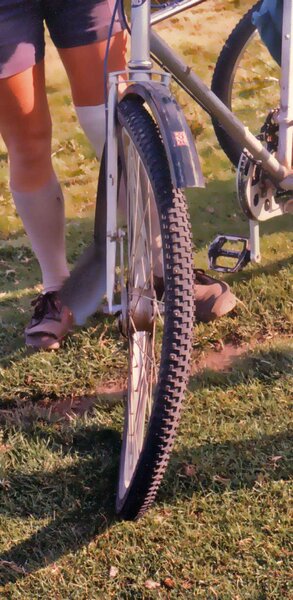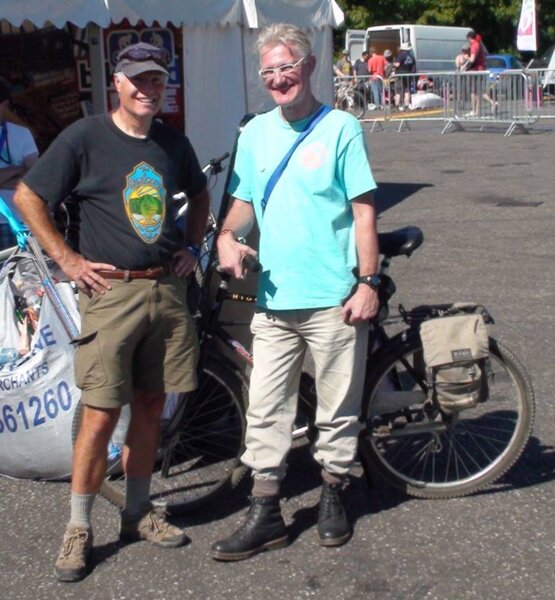toons":3se9z89i said:Great thread loving the history lesson.
Why o why did the Brits stop using Drum brakes?
Cantilever brakes in the British weather make no sense.
I remember been very envious of Frank Hutton (Morpeth Bikes RIP), he had a set on his custom made frame. I remember riding in Kidland forest, it was extremely muddy and Frank demonstrating how good his brakes were.
The Brits never did use hub brakes on bicycles ~ they turned-up very rarely, but we never embraced the idea as did (and still do) the dutch.
In the early days of mountain-biking the vast majority were against the concept of hub braking, so much so that one of Jo's 'Mint Sauce' cartoons showed a mountainbiker with cricifixes and garlic because he was on a ride with another rider on a bike fitted with HUB BRAKES!
Yes, there was a lot of prejudice against any form of hub brake then, and it still exists a bit today.
To some extent, the prejudice was justified because the typical drum brake (Sturmey Archer and Sachs) available then did not work particularly well, although they were, in principle, a better brake than any rim brake. The problems were subtle, and we need not go into details here.
A little bit of personal history here: The first hub brakes I got hold of were from bikes dumped in ditches. Some were Sturmey Archers, dating from the thirties. I considered the possibility that Sturmey may still make them and plagued my local bike shop for information, but they repeatedly told me that hub brakes were no longer manufactured. One day I walked into the shop to discover the Sturmey Archer representitive there, so I did not loose the opportunity of peeping over his shoulder at the catalogue he had out on the counter while talking to the shop owner. There they were! Hub brakes!! I couldn't believe my eyes! After I'd busted into their conversation, the rep explained that this was the export catalogue (He'd mislaid his UK one) and that the hub brakes were not available. Huh, not me mate. Before he left the shop that day, I had extracted a promise that I could order a set. It was like pulling teeth. Little wonder parts of British Industry at that time was in the doldrums.
The Sturmeys I got were a disappointment in their performance, but still better than rim brakes. I have high standards. A brake doesn't just stop the wheel going round ~ it's the action that comes before that which is critical. Not to mention the rim wear, maintenance and constant adjustment associated with rim brakes.
So, the hunt for better hub brakes was on. This took another ten years. They were discovered in 'The Tandem Centre' in the Old Kent Road, London. This shop had a rather strange attitude and treated me with great suspicion, sometimes denying that they old drum brakes at all.
However, these brakes were 'the business' ~ superb braking characteristics. I couldn't figure this out, but a few years later, Dave Wrath-Sharman analysed the internal mechanism, explained to me why they worked so well, and went on to develop the 'floating cam' design idea. They may have worked supremely, but the quality of manufacture was not the best, so the weight was more than it needed to be. However, the main problem was that the spoke flanges were not wide enough apart, this I guessed was because they were designed for small-wheeled mopeds. The hubs had no brand name on them, just the letters SVDG (or something like that) which effectively meant; made in France. How I discovered that these hubs were made by a company called 'Leleu' or that the factory was in Lyons, I can't remember, but in short order, a letter went off to them, in french, asking about any other designs, how to order in quantity, etc, etc.
Leleu seemed as reluctant to part with their product and any information about it as were Sturmey Archer.
Eventually a consignment arrived. By now I was fitting rear hubs to both wheels because the spoke flanges of the rear were wider apart and the axle stronger. All the hubs needed modifications before being built into the Cleland wheels.
At somewhere around this point in this little history, Cleland Cycles went down the toilet, courtesy of the late Ron Kitching Esq, who sent the bailiffs in.
There follows an interlude, during which Sturmey Archer opened one eye in their long snooze, and invited Dave Warth-Sharman and self to a day's discussion about hub brake design, production and marketing. The outcome of which was the experimental prototype run of 50 (25 pair) of 'floating-cam' hubs. These are easily identified by their plain (without lightening holes) spoke flanges. These were a marked improvement on the original Sturmeys and worked very well indeed. Frank Hutton was in receipt of a set, and made it his business to demonstrate them to anyone who stood still long enough. They were also distributed to other movers and shakers in the mountainbike world of the time. Unfortunately, these super little brakes had a nasty habit of snatching and locking-on at unexpected times. I was assured that in the next run, this problem would be resolved, but the damage had been done. Word was, "we told you so, hub bakes are useless."
Another interval occurred, quite a few years this time, and Shimano come out with the Roller Brake.
Still huge amounts of mistrust in the mountain biking world to these brakes; lots of silly rumours about overheating etc.
I've been fitting them to my bikes for the past 12 years, and I say they are just about perfect: reliable, gentle action, unaffected by water (even underwater, see the vimeo video earlier in this thread), virually zero maintenance, and really relatively cheap.
I wonder if anyone is going to read these ramblings ...

